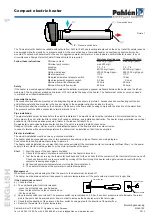
IX
-
FLUSHING PROCEDURE FOR LIME
SCALE REMOVAL FROM HEAT EXCHANGER
The amount of calcium carbonate (lime) released from water is in direct proportion to water temperature and
usage. The higher the water temperature or water usage and the harder the water (more dissolved calcium
carbonate), the more lime deposits are dropped out of the water. This is the lime scale that forms in pipes,
water heaters and on cooking utensils.
Lime accumulation reduces the efficiency and longevity of the heat exchanger coil and will cause the water
heater to malfunction. The lime scale may need to be periodically removed from the heat exchanger (indicated
by the "LC" code on the remote display). The usage of water softening equipment greatly reduces the
hardness of the water. However, this equipment does not always remove all of the hardness (lime). The heat
exchanger may occasionally need to be flushed to clear out the lime deposits. Use the following procedure
and diagram to flush the heat exchanger and remove the lime scale.
1. Disconnect power to the water heater.
2. Close valves in the cold water inlet and outlet supply.
3. Connect PVC hoses (may use garden hose to the drain valve outlet fittings). Connect a circulator pump to
the hose connected to the cold water inlet. See figure 11 for hose and circulator connections.
4. Pour 4 gallons of fresh vinegar into a 5 gallon bucket.
5. Place the ends of the hose into the bucket.
6. Open the drain valves to the hose fittings.
7. Turn on power to the circulating pump and allow the vinegar to circulate through the heat exchanger coil for
at least 45 minutes. Heavily limed heat exchangers may require several hours.
8. Turn off power to the circulating pump.
9. Run hose from hot water outlet to a drain.
10. Close the drain valve on the cold water inlet. Leave hot
water drain valve open. Open cold water inlet to flush with
fresh water.
11. Allow water to flow out of the hose for 5 minutes to flush
vinegar from the water heater.
12. Shut off cold water inlet valve. Remove filter screen and
clean out any sediment. Reinstall.
13. Close the hot water drain valve. Open the cold water inlet
and hot water supply valves.
14. Disconnect the hoses from the drain valve connections.
15. Restore power to the water heater and check operation.
54
Summary of Contents for Everhot IGI-180C-5N
Page 7: ...I GENERAL INFORMATION cont CUT AWAY ILLUSTRATION 7...
Page 8: ...I GENERAL INFORMATION cont SCHEMATIC ILLUSTRATION 8...
Page 21: ...V SEQUENCE OF OPERATION cont Operation Sequence Flow Chart 21...
Page 22: ...V SEQUENCE OF OPERATION cont Operation Sequence Flow Chart 22...
Page 23: ...V SEQUENCE OF OPERATION cont Sequence Timing Chart 23...
Page 24: ...V SEQUENCE OF OPERATION cont Sequence Timing Chart 24...
Page 30: ...Wiring Schematic 30...
Page 55: ...55 X PARTS BREAKDOWN Disassembled View Cabinet...
Page 56: ...X PARTS BREAKDOWN Disassembled View Internals 56...
Page 57: ...X PARTS BREAKDOWN Disassembled View Internals 57...
Page 58: ...X PARTS BREAKDOWN Disassembled View Electrical 58...
Page 62: ...62 Notes...
Page 63: ...63 Notes...











































